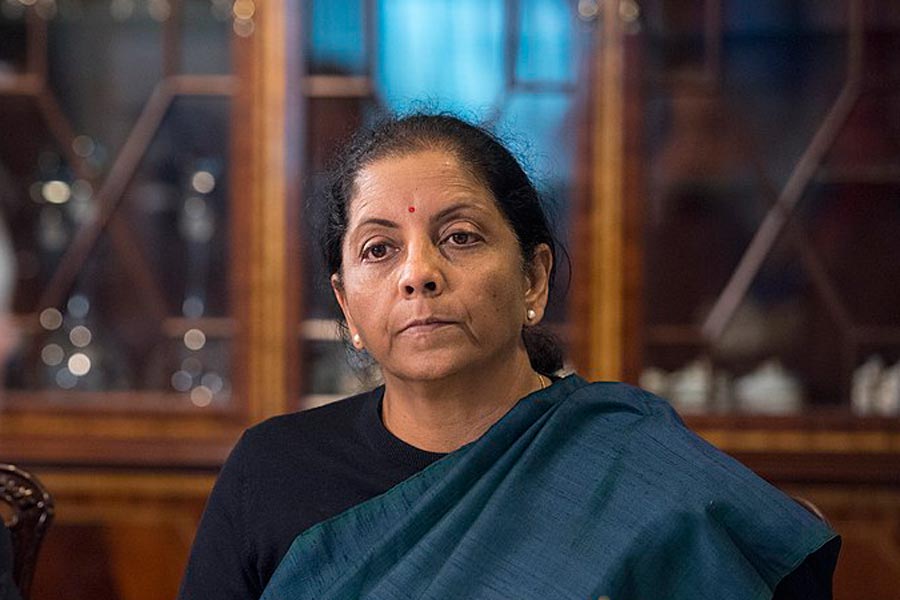If press statements had the power to lift an economy, Nirmala Sitharaman would have proved herself to be India’s best finance minister. Unfortunately, statements can conjure no such miracles and Sitharaman continues to be what she is: a minister who is completely clueless about the state of the economy.
Her stimulus programme, coming initially in ‘Equated Weekly Instalments’, and now with lesser frequency, has failed to make any mark and the economy continues to suffer from a persistent lack of demand.
In her much-fancied series of announcements, her primary focus remains presenting a rosy picture of the economy—and that is where the problem actually begins. The finance minister is in a perpetual state of denial. The first step to solve a problem is the recognition that the problem exists but Sitharaman refuses to accept that the economy is in deep trouble.
Sitharaman seems stuck with the problems of the UPA regime. While in Washington to attend the annual meeting of the IMF-World Bank last week, she told reporters that she was not indulging in blame game, but only recalling when and what went wrong during a certain period, which is absolutely necessary to put things in context. She is apparently fixated on the past and the present seems to be less important for her.
Her approach even prompted former Prime Minister Manmohan Singh to advise her not to be obsessed with the mistakes of the UPA government and instead fix the problems of the economy. The former prime minister suggested that the Modi government come out of its habit of headline management in running the economy. But this has been the mainstay of the finance minister’s stimulus packages.
Her first package, announced with great fanfare, was meant to boost demand—particularly in the automobile sector, which has been down in the dumps in the wake of a continuous slump in demand, both in passenger and commercial vehicles. Automobile manufacturers and the ancillary industry have been announcing production holidays and putting off new investments as they are stuck with inventories piling up. A perceived government preference for electric vehicles also acted as a dampener.
The finance minister announced a slew of measures to reverse the trend, including a new scrap policy and new norms in calculating depreciation values to encourage institutional buying, besides assurances to the effect that legacy manufacturers have nothing to fear from a change in government policy. But, there was no word on a keenly awaited cut on the GST rates from 28 percent to 18 percent, which came as a big disappointment for the whole industry.
The results have been quite predictable. Passenger vehicle sales declined the most in two decades in August due to a continuing slump in demand amid slowing economic activity and an increase in vehicle ownership costs. According to the Society of Indian Automobile Manufacturers (SIAM), passenger vehicle sales decreased by 31.57 percent in August, the tenth consecutive month of continuous decline and the sharpest fall since the body started compiling the data in 1977-98. The sale of commercial vehicles dropped even more, down by nearly 40 percent. Even two-wheeler sales were not spared.
There is no perceptible change in the consumer behaviour, which means the finance minister’s expectations were overblown and, whatever sops announced by her to revive the fortunes of the industry were too little and too late. The finance minister blaming the millennials’ preference for taxi aggregators like Uber and Ola for the woes of the automobile industry revealed her total disconnect with the reality.
The stimulus package for the housing and export sector, which came as another instalment of her so-called big ticket reforms programme, met with almost the same results. The new set of measures included a Rs 20,000-crore fund to support last mile funding of unfinished affordable and middle income housing units, and six different silos to address tax refunds, improved credit flow, providing for an additional Rs 36,000 crore to Rs 68,000 crore as export credit under priority sector and the creation of a mission for utilisation of Free Trade Agreements (FTA) with other countries.
It did not take long for the real estate sector to give thumbs down to the new announcements, which have not progressed beyond feeble gestures. The apex real estate group CREDAI has expressed its disappointment over Sitharaman’s measures as, according to them, these have failed to address key industry demands such as a tax rebate and lower interests for home-buyers and developers. They have dismissed the move for the creation of the 20,000-crore fund as of limited impact as it excludes projects that face insolvency proceedings or are in danger of becoming non-performing assets (NPA).
Curiously enough, she also announced a copy-cat shopping festival on the lines of the famous Dubai Shopping Festival (DSF) to try and boost retail demand. This should sound hilarious to anyone who is familiar with DSF as it shows the finance minister’s complete lack of understanding both about Dubai Shopping Festival and the problems with demand slump in the Indian economy.
Dubai has developed an art of creating hype around something and then converting it into an economic success. Whether it is Emirates airlines or its glitzy real estate showpieces such as the Burj Khalifa, Dubai has a way of doing things which no other place on earth has managed to master. A DSF-type shopping festival in India to boost domestic demand is nothing short of a joke.
Nirmala Sitharaman also announced a massive cut in corporate tax from 30 percent to 22 percent, accompanied by concessional rates for new companies, as a master-stroke in her latest stimulus package. Although the move was cheered by the markets initially, even such a major announcement has failed to alter the ground situation, which continues to cry for improvement to revive demand in the economy. Factories and shops continue to down their shutters, taking a heavy toll on jobs.
A slew of new numbers on the Indian economy has cast a shadow of distress across the sectors as production, consumption and consumer confidence are all showing consistent declines. It is not hype that India needs at this juncture; it requires hard core stimulus efforts that will help improve consumer confidence and step up credit flow across sectors.
Stripped down to simple terms, this means there is a need to improve the spending power of the people, for which existing jobs have to be protected and new ones created. The finance minister hopes her announcements would help increase production; but it is equally important to create corresponding demand to absorb the existing production. The measures announced so far have failed to do this. It is no wonder, therefore, that the so-called stimulus packages have failed to make any significant impact.
Nirmala Sitharaman’s performance so far has drawn some caustic comments all around. Former commerce minister Anand Sharma’s comments, for instance, were less than flattering. “Ministers can’t be flippant about a grave national crisis. They are wasting their energies either in denying the crisis—which we had warned against over the past two years, after the demonetisation—or making non-serious statements. That the government is clueless is not an ordinary problem,” the former UPA minister has been quoted as saying.
Even her economist husband Parakala Prabhakar has turned a bitter critic of her performance. That he is not a BJP loyalist is a different matter altogether.







